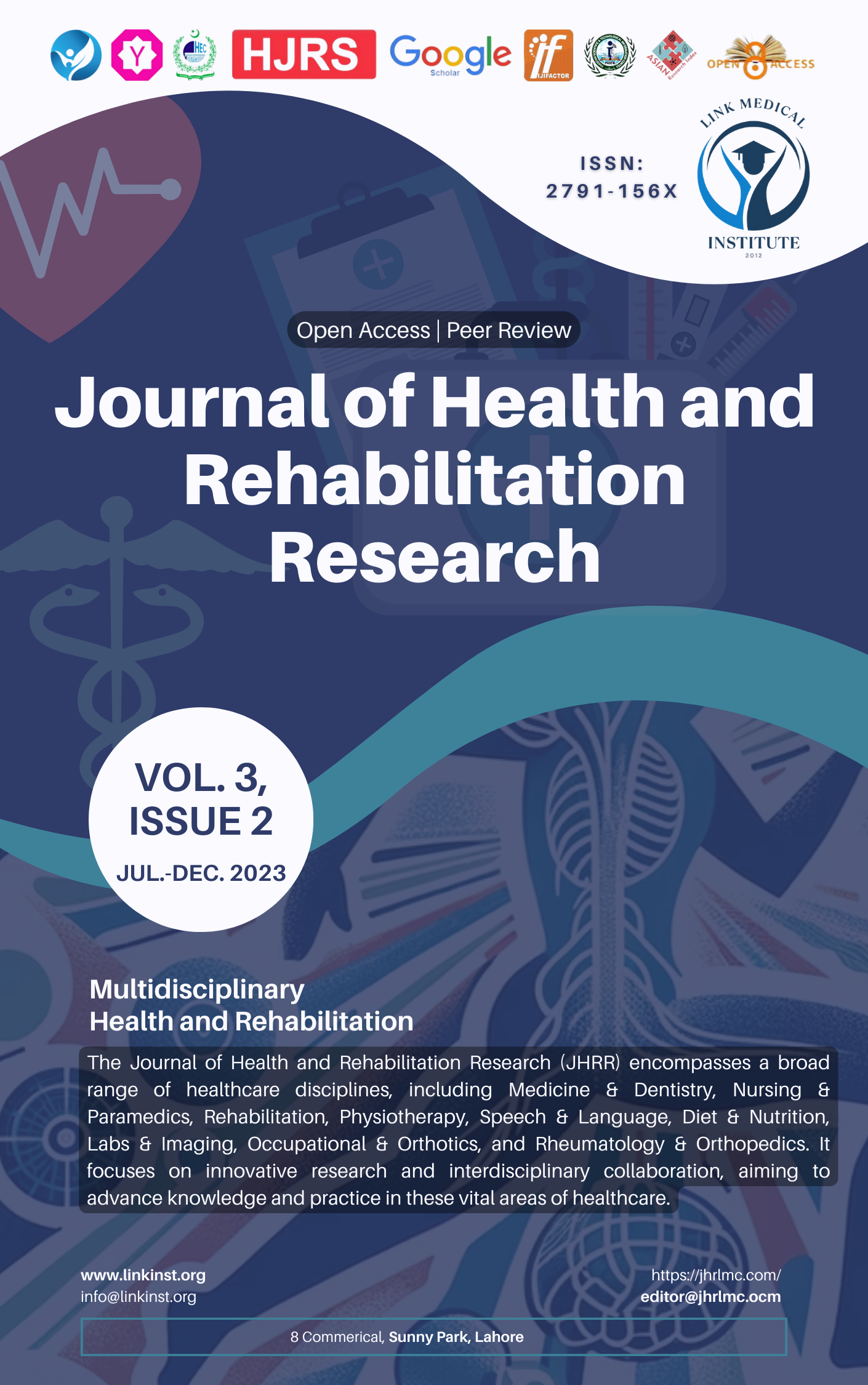A Cephalometric Analysis on Magnitude and Shape of Sella Turcica
DOI:
https://doi.org/10.61919/jhrr.v3i2.1737Keywords:
Sella turcica, craniofacial morphology, computed tomography, cephalometry, pituitary fossa, population-based study, age-related changes, U-shaped morphologyAbstract
Background: The sella turcica is a critical craniofacial landmark housing the pituitary gland. Variations in its size and morphology are significant in diagnosing syndromic conditions, pituitary pathologies, and craniofacial anomalies. Establishing normative data is essential for population-specific assessments.
Objective: This study aimed to evaluate the size and shape of the sella turcica in the Balochistan population, analyzing its correlation with age and gender.
Methods: This cross-sectional study included 142 participants (98 males, 44 females) aged 1–70 years. High-resolution computed tomography (CT) images were analyzed using Mimics software for precise measurement of linear and area dimensions, including anterior, posterior, and median heights, as well as length, diameter, and width. Morphological analysis categorized sella turcica shapes into U-shaped, J-shaped, and shallow. Statistical analysis was conducted using SPSS version 25. Gender differences were assessed using t-tests, and correlations with age were evaluated using Pearson’s coefficient.
Results: No significant gender differences were observed in sella turcica dimensions (p > 0.05). U-shaped morphology was most common (50.7%), followed by J-shaped (32.4%) and shallow (16.9%). Significant positive correlations were identified between age and dimensions, including length (r = 0.75, p < 0.001) and diameter (r = 0.73, p < 0.001).
Conclusion: The study established normative data for sella turcica dimensions and morphology, emphasizing its utility in orthodontic and craniofacial assessments. Age significantly influenced sella dimensions, while gender differences were negligible.
Downloads
References
Lechan RM, Arkun K, Toni R. Pituitary Anatomy and Development. Prolactin Disorders: From Basic Science to Clinical Management. 2019;11–53.
Yasa Y, Bayrakdar IS, Ocak A, Duman SB, Dedeoglu N. Evaluation of Sella Turcica Shape and Dimensions in Cleft Subjects Using Cone-Beam Computed Tomography. Medical Principles and Practice. 2017;26(3):280–5.
Acevedo AM, Lagravere-Vich M, Al-Jewair T. Diagnostic Accuracy of Lateral Cephalograms and Cone-Beam Computed Tomography for the Assessment of Sella Turcica Bridging. American Journal of Orthodontics and Dentofacial Orthopedics. 2021;160(2):231–9.
Kucia A, Jankowski T, Siewniak M, Janiszewska-Olszowska J, Grocholewicz K, Szych Z, et al. Sella Turcica Anomalies on Lateral Cephalometric Radiographs of Polish Children. Dentomaxillofacial Radiology. 2014;43(8):20140165.
Pittayapat P, Jacobs R, Odri GA, de Faria Vasconcelos K, Willems G, Olszewski R. Reproducibility of the Sella Turcica Landmark in Three Dimensions Using a Sella Turcica-Specific Reference System. Imaging Science in Dentistry. 2015;45(1):15–22.
Sathyanarayana HP, Kailasam V, Chitharanjan AB. Sella Turcica: Its Importance in Orthodontics and Craniofacial Morphology. Dental Research Journal. 2013;10(5):571.
Doyle F, McLachlan M. Radiological Aspects of Pituitary–Hypothalamic Disease. Clinics in Endocrinology and Metabolism. 1977;6(1):53–81.
McLean A. Pituitary Tumors. Raumbeengende Prozesse. 2013;14:242.
Shaw DR. Cephalometric Regional Superimpositions: Digital vs. Analog Accuracy and Precision: 3. The Cranial Base. Nova Southeastern University. 2014.
McCaffrey KP. Cephalometric Regional Superimpositions: Digital vs. Analog Accuracy and Precision: 2. The Mandible. Nova Southeastern University. 2014.
Li P, Kong D, Tang T, Su D, Yang P, Wang H, et al. Orthodontic Treatment Planning Based on Artificial Neural Networks. Scientific Reports. 2019;9(1):2037.
Alcañiz M, Montserrat C, Grau V, Chinesta F, Ramón A, Albalat S. An Advanced System for the Simulation and Planning of Orthodontic Treatment. Medical Image Analysis. 1998;2(1):61–77.
Sennimalai K, Vichare S, Rana SS, Lal B, Selvaraj M. Cephalometric Analysis Using Three-Dimensional Imaging System. In: Applications of Three-Dimensional Imaging for Craniofacial Region. Singapore: Springer Nature; 2024. p. 143–67.
Dang N. 3D Superimpositions in Orthodontics: A Review of Current Techniques and Applications [Master's Thesis]. University of Southern California.
Juneja M, Garg P, Kaur R, Manocha P, Batra S, Singh P, et al. A Review on Cephalometric Landmark Detection Techniques. Biomedical Signal Processing and Control. 2021;66:102486.
Hasan HA, Alam MK, Abdullah YJ, Nakano J, Yusa T, Yusof A, et al. 3DCT Morphometric Analysis of Sella Turcica in Iraqi Population. Journal of Hard Tissue Biology. 2016;25(3):227–32.
Tepedino M, Laurenziello M, Guida L, Montaruli G, Troiano G, Chimenti C, et al. Morphometric Analysis of Sella Turcica in Growing Patients: An Observational Study on Shape and Dimensions in Different Sagittal Craniofacial Patterns. Scientific Reports. 2019;9(1):19309.
Babu MM, Vivekanand B, Mythili A, Ramesh J, Subrahmanyam KA. ESICON 2018 Abstracts. Indian Journal of Endocrinology and Metabolism. 2018;22(Suppl 1):S17–93.
Beaulieu R, Parikh P, Ekeh AP, Markert RJ, McCarthy MC. Early Prediction of Trauma Patient Discharge Disposition.
Baidas LF, Al-Kawari HM, Al-Obaidan Z, Al-Marhoon A, Al-Shahrani S. Association of Sella Turcica Bridging With Palatal Canine Impaction in Skeletal Class I and Class II. Clinical, Cosmetic and Investigational Dentistry. 2018;10:179–87.
Muhammed FK, Abdullah AO, Liu Y. Morphology, Incidence of Bridging, Dimensions of Sella Turcica, and Cephalometric Standards in Three Different Racial Groups. Journal of Craniofacial Surgery. 2019;30(7):2076–81.
Alkofide EA. The Shape and Size of the Sella Turcica in Skeletal Class I, Class II, and Class III Saudi Subjects. European Journal of Orthodontics. 2007;29(5):457–63.
Yassir YA, Nahidh MN, Yousif HA. Size and Morphology of Sella Turcica in Iraqi Adults. Mustansiria Dental Journal. 2010;7(1):23–30.
Downloads
Published
How to Cite
Issue
Section
License
Copyright (c) 2023 Marium Hasni, Nasrullah Mengal, Bibi Masooma, Maria Zehri, Zeenat Razzaq, Aminullah, Irfan, Mehreen Butt, Fakhira Nizam, Masooma Hameed, Munir Ahmed, Sumbal Hayat

This work is licensed under a Creative Commons Attribution 4.0 International License.
Public Licensing Terms
This work is licensed under the Creative Commons Attribution 4.0 International License (CC BY 4.0). Under this license:
- You are free to share (copy and redistribute the material in any medium or format) and adapt (remix, transform, and build upon the material) for any purpose, including commercial use.
- Attribution must be given to the original author(s) and source in a manner that is reasonable and does not imply endorsement.
- No additional restrictions may be applied that conflict with the terms of this license.
For more details, visit: https://creativecommons.org/licenses/by/4.0/.






